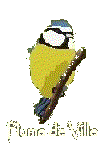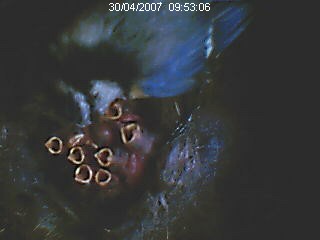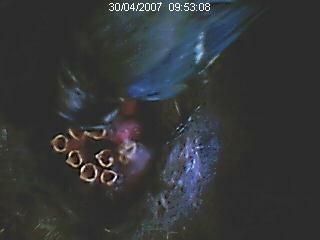Plume de Ville
Blue Tit 2007

 Blue
Tits 2007
Blue
Tits 2007Link WEBCAM: watch in live the last webcam picture inside the nest!
28 April BIRTHS!
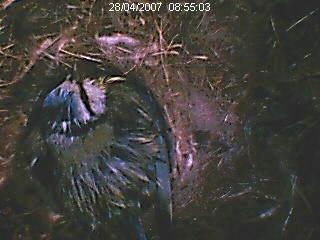
Early this morning, she
took a bath and entered drenched in the nesting box.
This
morning with 9h30 let us see we see her looking at its eggs very lengthily the
head in the bowl of the nest. Then we remain attentive.
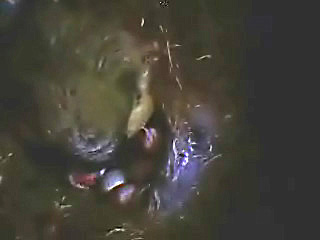
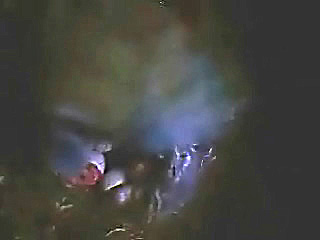
First meal. Ulysses brings
immediately a caterpillar, the same size of the chick! Intrigued, he looks
lengthily in the nest, then quits.
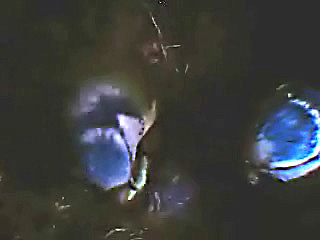
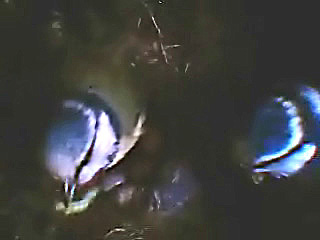
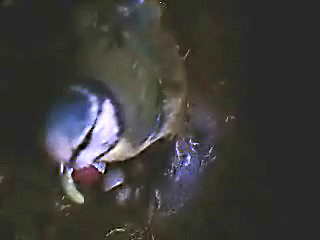
She will try to feed her
first chick with the caterpillar. She will exert much patience, but a last she
must accept the evidence: it is a little too large and a little too early. She
will eat the caterpillar herself. One sees three eggs, watch in the video the
3rd in the bottom along the nest edge.
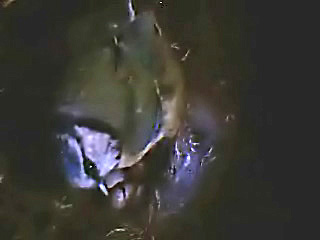
The egg in
bottom right beside under her beak is just splitting. The small black feature
is where the egg is opening. The eggs split in half by the middle (as we break eggs
for an omelet, if I mai say!).
The egg
moves more and more, she looks at it attentively. Now the shell is broken.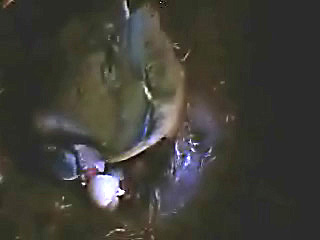
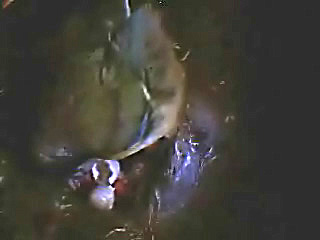
Little by little the
chick gets free.
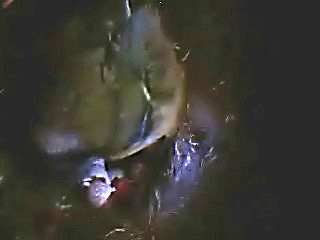
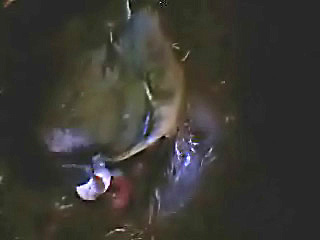
By now he
wears a small hat. he got free from only half of the shell.
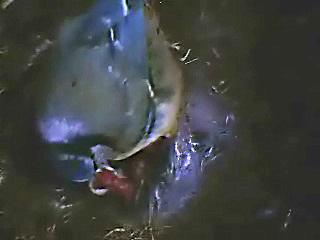
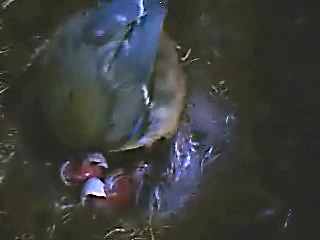
Finally he gets free from
other half. Immediately she will eat the empty shells. She laid 12 eggs and she
to recover as much calcium as possible from the shells.
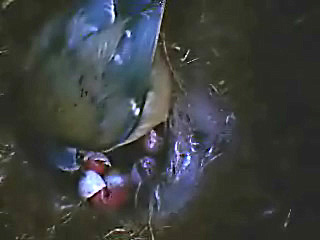
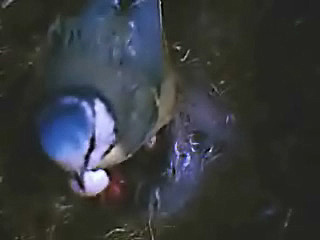
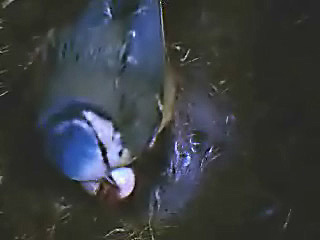
Here, we
are two.
She eats
the shell of first chick.
Hatching number 1 and 2. Watch
VIDEO (1080Ko, 4mn) .
Hatching number 2. Watch
VIDEO (680Ko, 2mn14s)
.
The original sequence
lasted 7 minutes; it has been cut to avoid too large loadings
9h50 the second one is born, the father is very attentive there, and he brings a beakful. After some attempts Penelope ends up having the beakful. Look at attentively the video; she must draw the caterpillar regurgitated by Ulysses. A little later he will nourish chicks too, and even if Penelope asks to be feed (or encourages him?), it often happens that he is does not care about her, keeps his caterpillar and goes directly to the nest and nourishes itself the chicks. When he nourishes his chicks he is very patient. It waits patiently that a chick opens the beak; he does not dare to touch the chicks. This is not completely the case of the mother, who shakes a little all her offspring and does not hesitate to turn over the whole! If both have a "delivery" in the beak, the late arrived patients outside then ends up entering and awaits its turn at the edge of the nest.
Here he is, discovering his chicks for the first time. It is touching. He will remain a long time looking at them, a little astonished, Penelope remains on the edge of the nest. Watch VIDEO (492 Ko, 1mn06)
He is at top of the photograph, recognizable to the white band in the head more marked than her. Also his nape of the neck is whiter (not visible on this photograph).
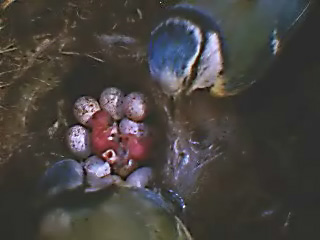
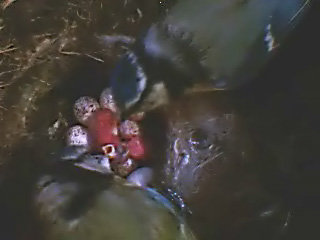
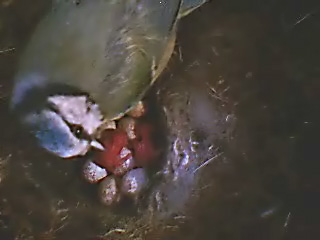
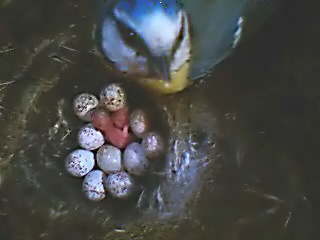
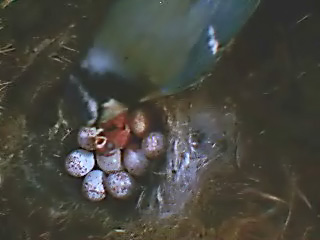
10h57: only
two chicks are born for the moment. All small asking yellow beaks! The chicks
are not larger than the nail of the small finger. Their mother is just
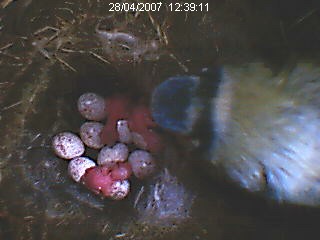
13h28: And four. Watch VIDEO (1290Ko, 3mn27s)
She is very attentive to look at the beginning exit from the egg then, once the chick is safe, because he is free from the first half of its shell, she leaves the nest letting him manage alone the continuation. We see her outside, smoothing her feathers. The new chick is free now and she enters again the nest and eats the two halves of the shell. She is much more attentive with the hatching of her first chicks, thereafter she will look a little and leave to the supplying letting the hatching be done, the feeding also is essential
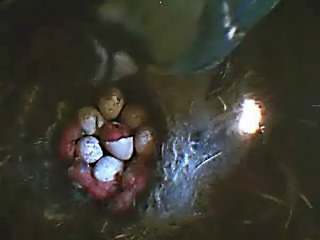
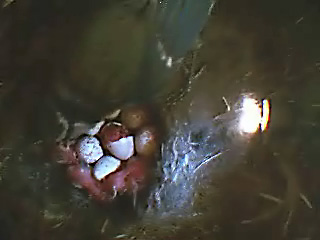
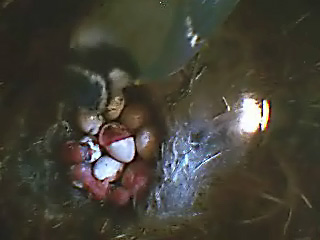
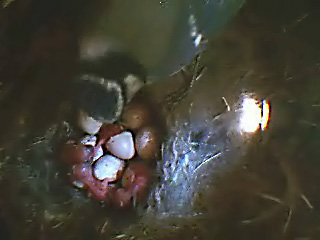
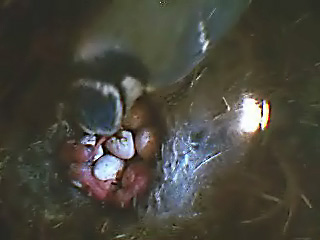
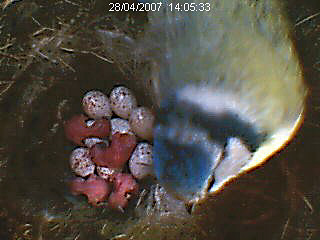
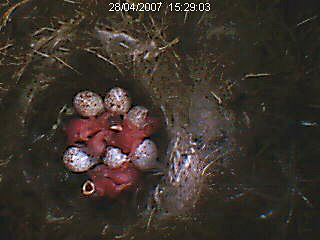
15h30: Six.
Not very easy to count because they are tangled up (and there are only 6).
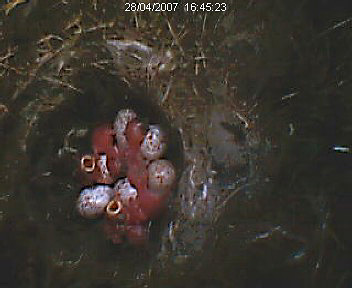
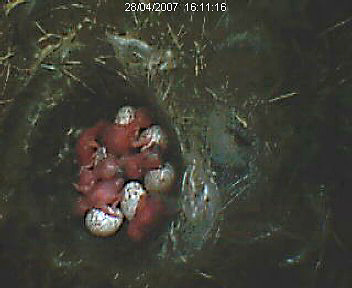
He comes
also to nourish them. When he arrives and she leaves, they have both the same
small beating of wings one in front of the other. He often enters the nest to
nourish the chicks.
She also
deals with the cleanliness of the nest and recovers the fecal bags of chicks.
She swallows them for the moment. A little later, when the chicks are taller,
she will take them out and discard them a little further.
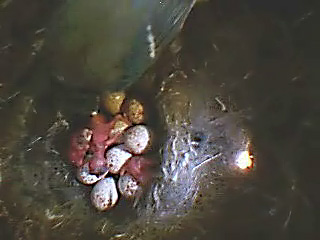
The small one takes its
position and his/her mother recovers the object (the small white point). Look
at him; he made his way to come under the beak of his/her mother.
Voir
VIDEO (100Ko, 16s)
This
morning during the hatching of the first chicks, Ulysses brought enormous
caterpillars larger than the chicks, like those which we had seen the previous
days and which she had some difficulties to swallow. This afternoon he brings
smaller caterpillars, more adapted. Is this a fluke or a will of beakfuls of the
size of the small beaks?
Around 20h numbers 7 and 8 will hatch. All the brood
(or almost?) in one day, spaced hatchings of approximately three hours (two by
two). However the laying was spread out over 12 days. It would be interesting
to know the order of hatching compared to the order of laying. All the small
ones will have a similar development. And all the small ones are nourished with
equality. If one does not asks at the same time as the others, the father or
the mother requests him until he raises the head and opens the beak.
29 April
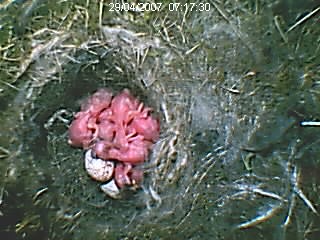
A chick
mass which agitate and opens the beak!
There is only
eight of hatched eggs and not ten as we thought previously. It is very
difficult to count them and see the number of remaining eggs, but using several
photographs one manages to see fugitively that there remain 4 un-hatched eggs
and, sometimes, to count the number of yellow beaks.
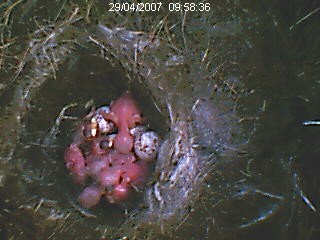
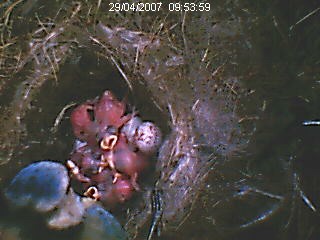
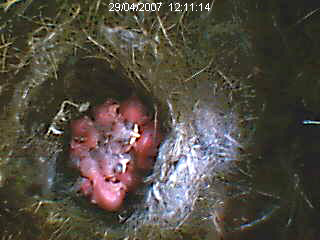
They
already changed since their birth and one now sees their large beaks surrounded
by a yellow moustache and the large spheres of the still closed eyes. But they
are not dumb! They all chirp when one of the parents arrives. Preferably they
keep the head towards the center of the nest.
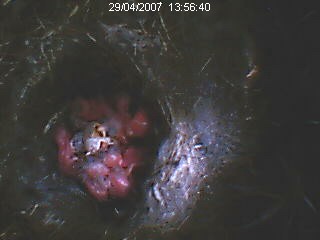
We do not
have the absolute proof yet but the small white spot in the middle strongly resembles
the hatching of number 9.
Later, other
photographs will enable us to count the number of heads and beaks. Then, 9?
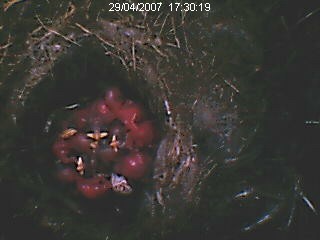
The nest at 17h 30.
Other the small white
spot, we do not see any more un-hatched eggs. Last year, with only four, we had
difficulties to see the four together. Now with 8 or 9, it is not easy. In any
case the small troop is in full form and is agitates continuously
Storm in the
evening and a little rain.
30 April
The weather
is always nice, a little fresher 22-
The food
shuttles continue. Three to four feedings ensured by the two parents, then a
ten minutes break whilst she it broods and turns over the chicks as if they
where eggs, the head plugged in the middle of the nest in the crawling mass,
its head playing the role of a large spoon. As from dawn they are already hunting
and make ceaseless shuttles which last all the morning. Less journeys in the
afternoon. For the moment, the chicks are extremely well nourished and full of vitality.
It is a great difference compared to last year, and where the resources were
rarer and where one and the other left up to one hour. The climate is not the
same one, the previous year it still froze in the mid-April nights. This year
the weather was hot, caterpillars developed well.
It seems
that there are 8 chicks. At least all our analyses of the photographs we only
count unambiguously whether 8 nozzles or 8 heads (or 8 nozzles + heads!), with
always a small incertitude, we will see.
.
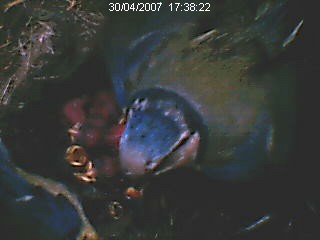
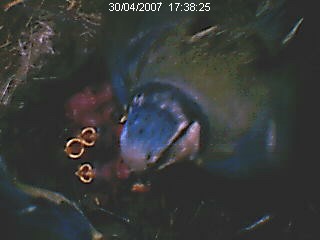
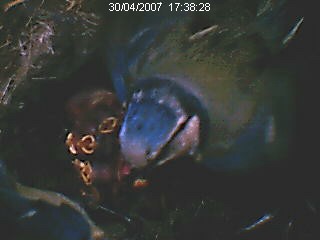
A faint acute cry and
yes, a delivery. It seems that she brings another thing than green caterpillar
(it is Penelope here, see the band of the head and also the wings a little opened),
but we did not succeed yet tot take a photograph which makes it possible to
recognize the insect.
The spoon! Stir, stir...

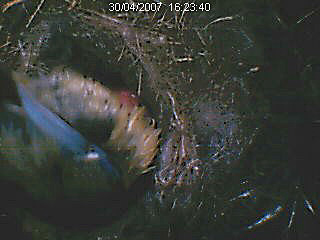
Sometimes
the beakfuls are difficult to swallow. Here Ulysses as a perfect houseman which
brings the meal and does the housework. Notice that he “takes out the dustbins”
contrary to Penelope. It is well him with his white band and its “silver back”.
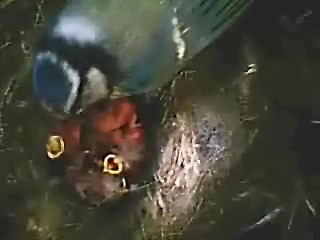
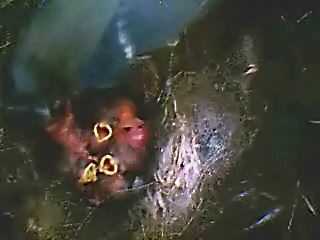
Be reassured,
the beakful will pass! The appetite is solid and the chirps too.
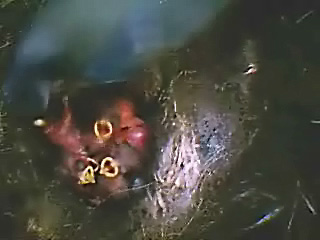
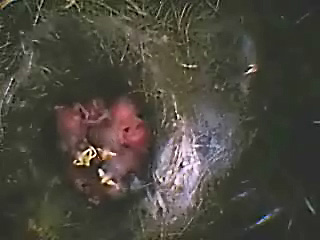
Always Monsieur. This beakful
also will be swallowed.
Sorry not yet translated , Translation in progress.
Happy 1st May
Surprise!
The photographs of 9h40 show the female eating what
is obviously an egg shell. Curious. We will have to wait one hour more to be
able to count… nine beaks.
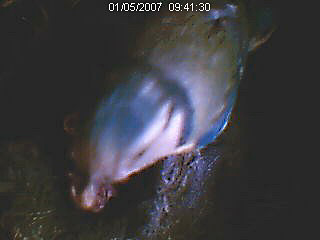



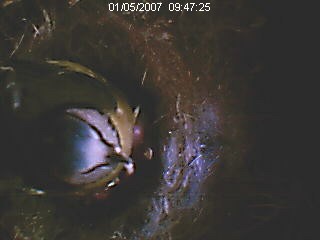
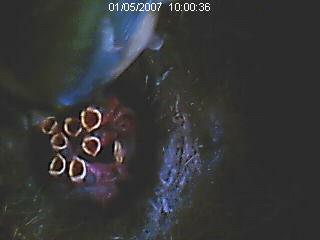
Yes it is
well a new birth. It is quite NEW! Probably born towards 9h30. The nine yellow
beaks can be distinctly seen.
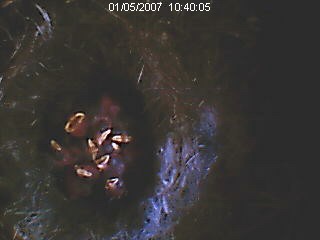
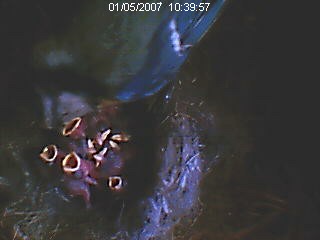
The day is full of
surprises. They are ten! Count at 11h48: TEN chicks! 9 yellow nozzles + a body
(the one in profile, the large one, of which one sees the wing and the leg, but
which the head is not visible).
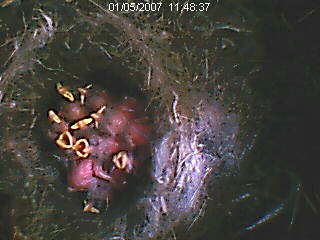
Is this the
Sunday-one which finally appears today? It is so difficult to distinguish them individually
among this heap of chicks.
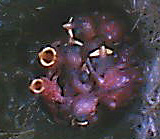
We do not know if it is
the case for both but at least that of this morning has 3 days of difference
compared to his/her brothers and sisters. One sees the difference in size between
the two small open beaks
In the high
side of the nest, a very small chick compared to the others. It is well a chick
of the day.
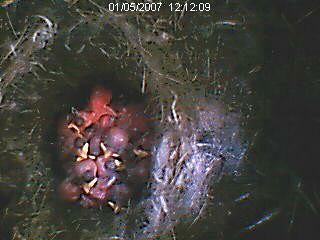
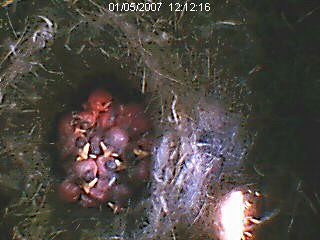
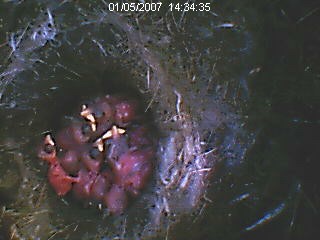
He has a hard time to stay in the center of the nest and he is rejected to the periphery of the nest (on the left).
Here is Ulysses,
recognizable at his white collar and also at his appointed place in the nest.
He always perches in the top and at the right of the image when he enters. And Penelope
is posed in bottom of the image. An agreement between them which avoids “stepping
on the other's toes”? Here he is with a large meal which is hard to swallow.
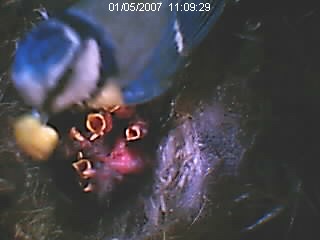
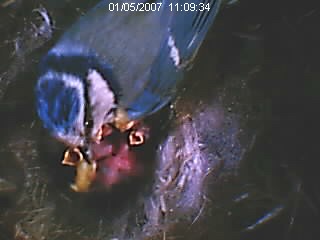
One minute later it is always trying to share its morsel. She joins and helps him, with two beaks it is easier to divide the beakful
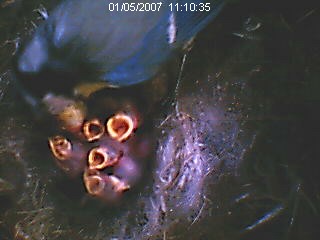
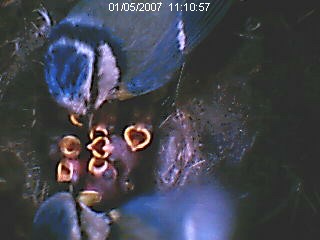
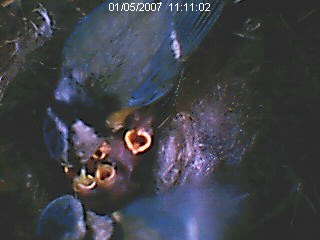
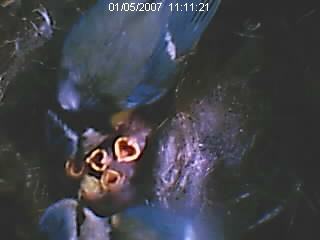
Interrogation: coquille du numéro 11 ou sac?
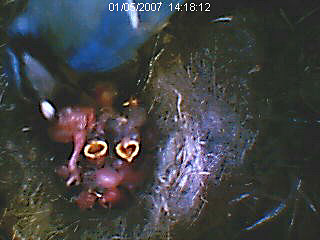
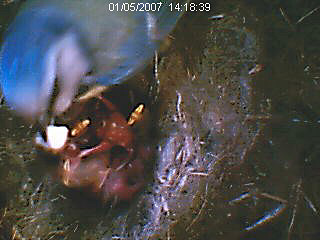
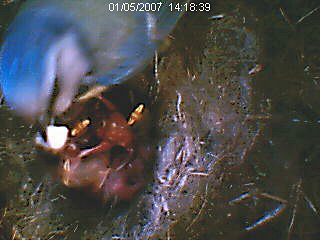
A little large for a
bag. Unfortunately no other photographs for the moment. The first photo one makes
lean towards the idea of a bag but after having been misled several times since
Sunday, only the following photographs will allow to be certain (with a little chance).
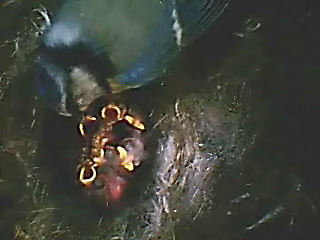
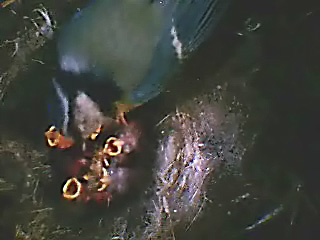
Here is Ulysses
bringing a caterpillar. He awaits his turn. In the nest one hears chirp. He
beats wings quickly. She takes the same posture when she brings a good morsel.
If both of them are there, they put opposite one the other and agitate the
wings frantically. It is the same movement as during the mating.
This
evening there is variety in the menus: insects and some beakfuls of pear.
How many
they are? No, still we don't know. There is not a clear photograph. Let's wait
tomorrow.
NEXT
